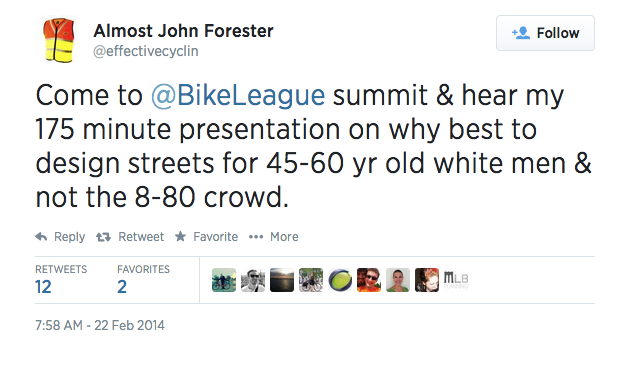Mass Cycling
Within Peter Furth’s chapter of City Cycling, he provides an overview of practice and perspectives related to bicycle infrastructure for mass cycling in American and European cities. Furth defines “mass cycling” as the prevalence of cyclists representing a reasonably broad majority an area’s population (often described elsewhere as the 8 to 80 population segment).
Cycling in America has long been the hallmark of middle-aged white males in cycling specific clothing (e.g. lycra, spandex, etc.) and is mostly utilized for recreation and exercise. Meanwhile, in The Netherlands, cycling is an everyday form of transportation for everyone from small children to pregnant women and the elderly. In cities with infrastructure for mass cycling, not only do more people cycle, but broader populations of people cycle. While the lycra folks may be satisfied with wide outside lanes as “bicycle accommodations”, a large majority of the population needs dedicated cycling infrastructure to feel safe and comfortable cycling.
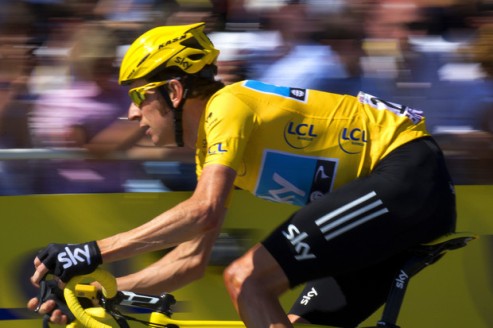
Racing cyclist in cycling specific clothing
Image Source: http://www.bloomberg.com/news/2012-10-08/middle-aged-men-in-lycra-becoming-target-for-bike-makers-retail.html
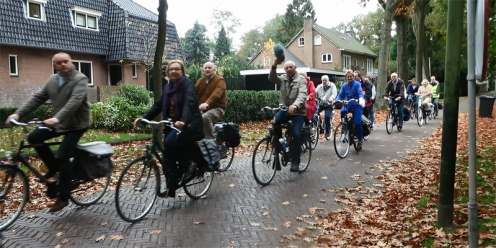
Seniors cycling casually in The Netherlands
Image Source: http://bicycledutch.wordpress.com/2013/10/31/elderly-people-on-a-cycle-tour/
Bicycle Infrastructure
I will briefly highlight the main categories of bicycle infrastructure, listed by level of traffic separation from greatest to least.
Standalone Paths
Standalone paths run on their own right-of-way and do not follow the alignment of a road for motor vehicles. They do often follow the alignment of existing or abandoned rail corridors, as these offer relatively flat and continuous stretches of land with minimal street crossings. Anecdotally, this is the type of bicycle infrastructure that nearly all cyclists are comfortable riding upon, and offers the highest level of traffic separation. They are often used for recreation, and are generally shared with other non-motorized users such as pedestrians or roller-bladers. However, in urban areas, they can be also see high levels of commuter traffic. I ride a standalone path in a rail corridor (the Springwater Corridor Trail) along the Willamette River from the Sellwood neighborhood of Portland to Portland State University in downtown Portland nearly every day, as do many other commuters year round.
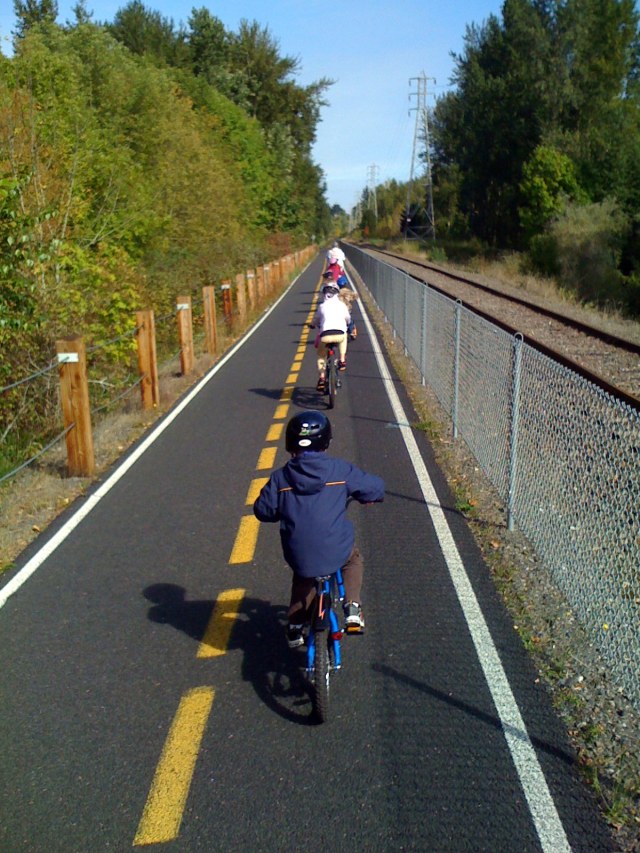
Springwater Corridor Trail in Portland, OR
Image Source: http://sellikengroup.com/files/2010/10/Spring-water-Corridor.jpg
Separated Path
Separated paths are very similar to standalone paths except for the fact that they follow the alignment of a road. These are heavily used by recreational and utility riders as well, but offer slightly higher levels of traffic stress, especially since intersections with driveways offer greater potential for conflicts.
Protected Bike Lanes
Protected Bike Lanes are called “Cycle Tracks” by Furth and many others, but this term is a bit colloquial; “protected bike lanes” is the term preferred in most recent technical literature. While protected bike lanes come in many different flavors, the main qualification for a protected bike lane is that there is some physical separation between cyclists and traffic. This differentiated protected bike lanes from buffered bike lanes, which provide more space between cyclists and traffic but no physical barrier.
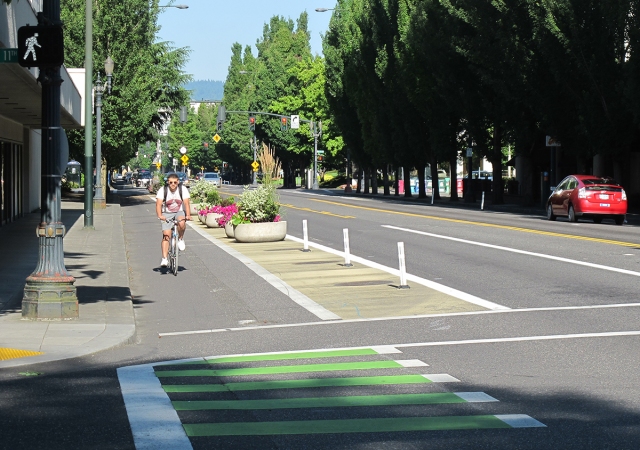
Protected bicycle lane along Multnomah Blvd in Portland, OR. See planters and posts used for physical seperation. Car parking is also a common solution for physical protection.
Image Source: http://otrec.us/images/uploads/Mult_lane.jpg
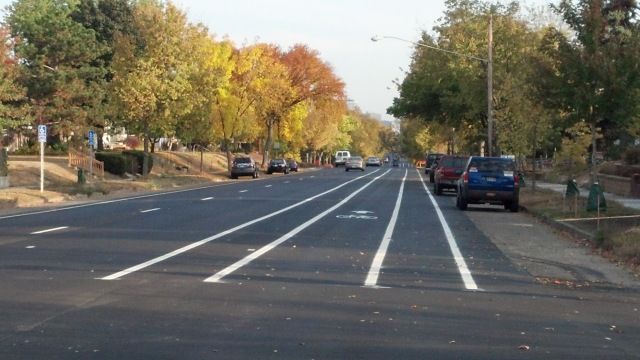
Buffered bike lane in Twin Cities
Image Source: http://streets.mn/2012/11/01/beyond-park-and-portland/
Bike Lanes
Bicycle lanes are used on many roads to separate bicycles from traffic using painted lines. These can be beneficial in helping cyclists to claim legitimate space on the roadway, and can often be implemented at low cost because they are primarily constructed using paint (other elements include signage, signaling considerations, etc.). Bicycle lanes can range in width, with four feet being the standard minimum, and more offering greater comfort for cyclists. Most bike lanes greater than six feet are striped with buffer strips (see above), as large bike lanes can be misconstrued as parking or motor vehicle lanes. In some rural areas, paved shoulders of four feet or more can serve as stand-in bike lanes, as long as they are kept clean of debris.
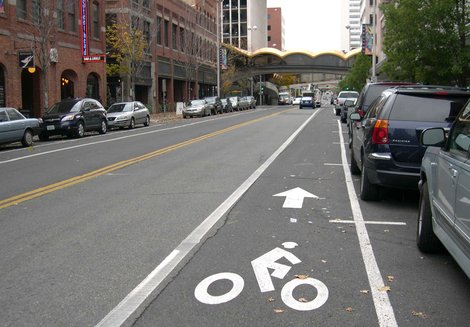
Bike lane in Spokane, Washington
Image Source: http://www.spokesman.com/tags/spokane/blogposts/
Shared Lanes and Bicycle Boulevards
There are many variants of shared lane treatments (where bicycles and motor vehicles share a single traffic lane) with differing levels of traffic stress inflicted upon the user. In Seattle, many “bicycle facilities” are simply sharrows painted on to arterial roadways, which should not be considered bicycle accommodation (apologies for singling out Seattle, this is where I have most recently experienced frustration with sharrows). Sharrows can be useful in legitimizing bicyclists, especially in cities where bicycling is only beginning to become prevalent, but only on roadways where the prevailing traffic speed is similar to that of a bicycle (15-20 mph).
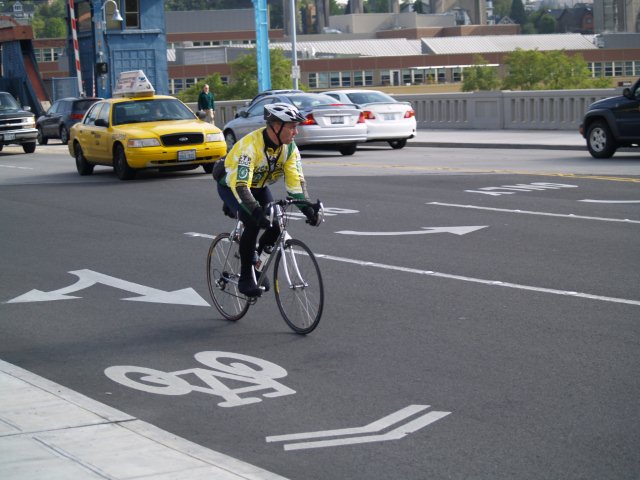
Example of sharrow on high traffic roadway
Image Source: http://www.cascade.org/sites/default/files/wp-content/Image-28_alt_sharrow_small.jpg
Sharrows are used as a small piece of the highly successful bicycle boulevards implemented in Portland, OR and other cities (primarily on the west coast). Bicycle boulevards use traffic calming strategies (speed humps, narrow cross sections, etc.) and traffic diverters to keep motor vehicle volumes and speeds low. The primary purpose of the sharrow in this environment is routing for bicyclists, so they may know what streets will best accommodate them on their trip.
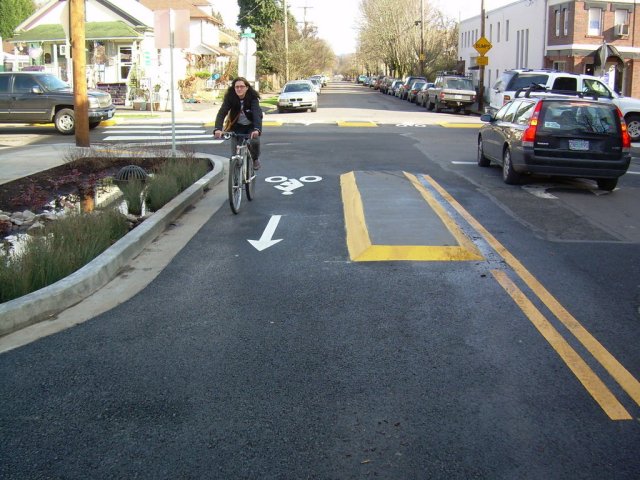
Bicycle boulevard intersection of SE Spokane and 13th in Sellwood (Portland, OR)
Image Source: http://media.oregonlive.com/portland_impact/photo/sespokanewof13th-lkge-a-020510jpg-31ae5548b0be2d9f.jpg
In some cases, lane geometry is the only element manipulated to enhance comfort for bicyclists. This takes two different tacts: lane widening and lane narrowing. A wide outside lane can provide room for both a motor vehicle and a bicyclist to travel side by side, but wide outside lanes also encourage faster vehicle speeds. Narrower lanes require the bicycle to take the lane and discourage fast vehicle speeds, but may increase driver aggression and lead to unsafe passing maneuvers. In general, more than lane geometry needs to be modified to provide safe and comfortable facilities for cyclists.
No Bicycle Accommodation
The last facility type is “none”, since cyclists can still legally ride on any road (except for most limited access freeways). In some cases, this is all that is available, and so cyclists may be found on this facility type. In the next section, the argument that “no facility” is the best facility will be examined, as it has had a profound effect on American bicycle facility design until recently.
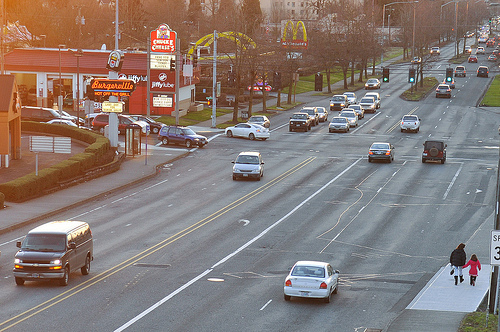
No bicycle facility, Powell Blvd. in Portland, OR
Image Source: http://bikeportland.org/2013/08/01/outer-powell-project-gets-4-9-million-for-street-safety-improvements-91466
Vehicular Cycling
A huge opponent of infrastructure for mass cycling in America has been the persistent ideology popularized by John Forester known as “Vehicular Cycling”. The basic idea of Vehicular Cycling is that cyclists are safest when they “act and are treated as drivers of vehicles”, and so it supposedly follows that separate bicycle infrastructure detracts from bicyclist safety. Forester’s ideology is not based on any credible empirical evidence (despite the impression that his 800+ page manifesto, Effective Cycling, may give) and is instead based on his anecdotal experience as a long-time bicycle commuter. Forester’s website (which looks to have been designed by someone adhering strictly to the philosophy of “Effective Web Design”) provides essays on various topics related to promoting Vehicular Cycling and serves as a point of contact for those who wish to become a part of the Vehicular Cycling movement.
Forester’s claims that separated bicycle infrastructure detracts from safety run counter to many studies of the success of separated infrastructure around the world (including here in America). Furth highlights several of these studies in his chapter, and many more have recently come out since. Colleagues at PSU’s Oregon Transportation Research and Education Consortium have released a multi-year study on the success of six different protected bicycle facilities as part of the Green Lane Project. See the People For Bikes repository for further studies on the successes of separated infrastructure.
This is not to say that separated infrastructure is superior or even necessary in all cases. Design judgements must be made based on the compromise between facility functionality and safety. For example, on many residential streets, shared lane treatments such as bicycle boulevards may be the better choice. But to say that separated infrastructure is inherently unsafe ignores the massive success it has around the world. There are good designs and bad designs for separated infrastructure, and consequently design is where the conversation should be taking place. It should seem intuitive that separating small, slow vehicles without roll cages or crumple zones from motor vehicles is beneficial when there is a significant speed differential, but the idea that cyclists need no separated infrastructure was much easier (and cheaper) for policy makers to swallow. It seems the tide is turning.
Humour
As a relevant bonus, here is one of my favorite twitter parody accounts, Almost John Forester. The twitter regularly offers ironic and wonky jokes about bicycle culture and current events in the transportation field.

